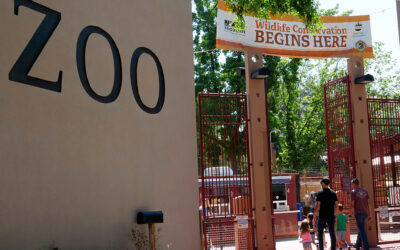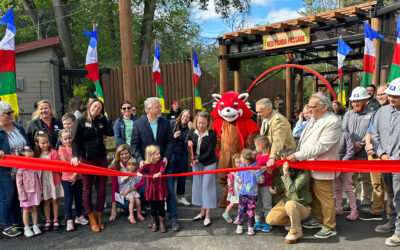Meet some of our favorite residents who aren’t bothered by colder temperatures.
Amur tiger

Female Amur tiger Akasha is spending her golden years at Zoo Boise in her “ReTIGERment Home”. She enjoys rolling around in freshly fallen blankets of snow and playing hide-and-seek with her zookeepers.
“Siberian tigers” are now more commonly called “Amur tigers” to reflect the species’ current natural range: an expanded region around the Amur River (where China and Russia meet). But the largest of all big cats still excels in the cold. They’ll hunt or patrol their turf even when temperatures plummet to -20° F! So, no matter how cold it gets in Boise, Akasha shouldn’t be affected.
(DID YOU KNOW: Like almost all big cats, tigers prefer a solitary life. They usually only live with others during mating season and when raising young. African lions are an exception to this rule; they live in social groups known as prides.)
Steller’s sea eagle

Zoo Boise’s male Steller’s sea eagle Vlad can be found perched in any of his favorite spots, frequently belting out his boisterous call. But sometimes, curiosity can get the better of him, and Vlad likes to strut right up to his main viewing window to interact with guests.
Little is known about Steller’s sea eagles due to the remote nature of their natural habitat: the rocky seacoasts and rivers of northeastern Siberia in Russia. But they have also been observed in North America, including off the coast of Maine.
We do know that these birds of prey spend much of their time perched on cliffs or in tall trees, looking for a potential meal. (‘Eagle eyes’ can see four to five times further than a person with perfect vision.) Once prey is spotted, Steller’s sea eagles swiftly swoop in and use their piercing talons to clamp onto future food and won’t let go until the prey is dead. Given their seaside homes, these eagles mainly eat fish.
(DID YOU KNOW: This eagle was named for Georg Wilhelm Steller, a noted 18th-century European zoologist and explorer. It is not a typo of “stellar”. These magnificent birds would fit the bill though: they’re the largest and most powerful among close relatives, the bald eagle and white-tailed sea-eagle.)
Red panda

There are two recognized types of red pandas. The big difference? Natural habitat adaptations. Styan’s red pandas (also called styani or Chinese red pandas) typically live in colder places than Himalayan red pandas. As a result, Styan’s have longer, darker-colored fur and larger bodies to stay warm.
All red pandas love to frolic and climb around all winter and are most active in the early morning. These acrobatic “fire foxes” have incredible balance, able to easily scale straight up or descend straight down.
Three red pandas currently reside in two different homes at Zoo Boise: male Himalayan red panda Spud, female Styan’s red panda Stevie, and male Styan’s red panda Jasper, who’s famous for sticking his tongue out!
(DID YOU KNOW: A brand new red panda habitat breaks ground in 2024! It will offer more climbing opportunities, adequate space for cubs, a window for guests to view the red panda day room, and more. See how you can help support new homes for other Zoo Boise residents.)
Magellanic penguin

Warm water penguin? Yep! Of the 18 global species of penguins, more live in and near warm water than cold water. Our Magellanic penguins are primarily found in the wild along the coastlines of Argentina, Chile, and the Falkland Islands, although sometimes as far north as Brazil.
Zoo Boise’s Magellanic penguin colony consists of nine penguins (five females, four males) who split time between their nests and zipping through the pool with mates and friends. The penguin pool at Zoo Boise uses well water, which has a consistent temperature. This is great, because it cools the penguins down in the summer and warms them up in the winter!
(DID YOU KNOW: Zoo Boise’s penguins share the Penguin Pavilion with Inca terns during the spring, summer, and autumn. This is just one of seven total multi-species homes currently in our zoo. Can you name them all?)
Snow leopard

Zoo Boise currently houses two snow leopards: male Sabu, the sweet one, and female Kabita, the sassy one. As primarily solitary animals, they share space in their habitat but live separately.
Snow leopards are specifically adapted to life in cold, high-altitude habitats. They use their long tail (up to 40″ long!) for balance and warmth, plus wide, furry paws for traction on snow and rocky terrain. Enlarged nasal cavities and a well-developed chest help snow leopards breathe in frigid, thin air.
A snow leopard’s white and grey-spotted coat acts as perfect mountain camouflage for this elusive, leaping hunter! That’s why this predator is nicknamed the “ghost cat” or “ghost of the mountains”.
(DID YOU KNOW: Snow leopards can’t roar. They purr, growl, or yowl instead.)
Red-tailed hawk

Zoo Boise’s female red-tailed hawk, Gamora, is native to this area and, thus, very familiar with our climate during the winter. It’s common for members of her species to never migrate and keep one permanent home.
Despite their name, a red tail is not a consistent way to identify red-tailed hawks. The best way is to look up for a black stripe on their wings while flying. And you’ll have plenty of time to check; a red-tailed hawk’s broad wings and tail allow it to soar for long periods without using much energy.
Note: Gamora is unable to fly due to an injury sustained in the wild before her rescue.
(DID YOU KNOW: The red-tailed hawk’s powerful call is a raspy and high-pitched scream. It’s often used in TV and movies to represent bald eagles as advertisers feel the hawk’s voice sounds more regal than the eagle’s!)
…and more!
More species than you may think are happy to spend time outside in the winter. For example, our African wild dog brothers [Cassius, Dax, and Teddy] are big fans of snow.
You can catch these animals and over 90 other species (many indoors!) daily at Zoo Boise from 10AM – 5PM. Last admission is at 4PM.
But mark your calendar for $3 Thursday discount days:
All zoo admissions are only $3 each every Thursday from December 2023 through February 2024. An inexpensive way to create a fun winter day or a wild family adventure right in downtown Boise!



